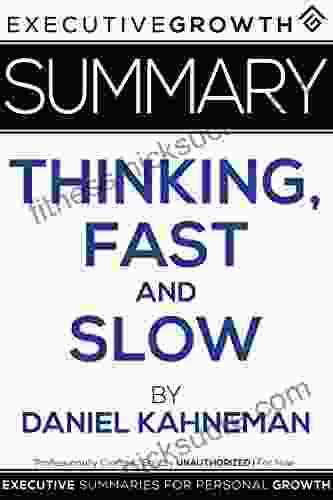Thinking Fast and Slow by Daniel Kahneman: A Comprehensive Summary and Analysis

Daniel Kahneman's groundbreaking 2011 book, "Thinking Fast and Slow," has revolutionized the fields of cognitive psychology and behavioral economics. This comprehensive summary and analysis will delve into the key insights and implications of Kahneman's dual-system model of the human mind, exploring its impact on decision-making, biases, and well-being.
4 out of 5
| Language | : | English |
| File size | : | 1322 KB |
| Text-to-Speech | : | Enabled |
| Screen Reader | : | Supported |
| Enhanced typesetting | : | Enabled |
| Print length | : | 66 pages |
| Lending | : | Enabled |
The Dual-System Model
Kahneman proposes that the human mind operates according to two distinct systems:
- System 1: Intuitive, fast, and effortless thinking. It operates automatically, based on heuristics and biases, and is responsible for quick judgments and emotional reactions.
- System 2: Deliberative, slow, and controlled thinking. It requires conscious effort, rational analysis, and logical reasoning to make decisions and solve problems.
System 1: Fast and Intuitive Thinking
System 1 dominates everyday thinking. It relies on mental shortcuts called heuristics to make quick judgments and inferences. These heuristics are often efficient and adaptive but can also lead to cognitive biases. For example, the availability heuristic refers to the tendency to judge the likelihood of an event based on how easily we can recall instances of it. This heuristic can lead to overestimating the risk of rare events.
System 2: Slow and Deliberative Thinking
System 2 is the more rational and controlled part of the mind. It is slower and more effortful than System 1 and is used when System 1 encounters a problem that requires more analysis. System 2 is responsible for higher-level cognitive functions such as planning, decision-making, and problem-solving.
Interactions Between Systems 1 and 2
Systems 1 and 2 interact constantly. System 1 provides fast and intuitive responses, which System 2 can then evaluate and refine. However, System 2 can also override System 1's judgments and make more deliberate decisions.
Implications for Decision-Making
Kahneman's dual-system model has significant implications for decision-making. System 1's reliance on heuristics and biases can lead to errors and irrational choices. For example, the framing effect refers to the tendency to make different decisions depending on how options are presented, even if the objective outcomes are the same. This effect is due to the way System 1 processes information and biases our judgments.
Implications for Biases
System 1's reliance on heuristics also makes us prone to various cognitive biases. These biases can distort our perceptions, influence our decisions, and lead to suboptimal outcomes. Some common cognitive biases include:
- Confirmation bias: The tendency to seek out information that confirms our existing beliefs.
- Anchoring bias: The tendency to rely too heavily on the first piece of information we receive.
- Hindsight bias: The tendency to believe that we could have predicted an outcome after it has already happened.
Implications for Well-Being
The dual-system model also has implications for our well-being. System 1's focus on quick judgments and emotional responses can lead to impulsive behavior and short-term gratification. On the other hand, System 2's ability for deliberate thinking and self-control can help us make more rational decisions and achieve long-term goals.
Applications
Kahneman's insights have practical applications in various fields:
- Behavioral economics: Understanding how cognitive biases influence financial decision-making.
- Marketing: Designing campaigns that leverage System 1's heuristics and biases.
- Public policy: Creating policies that reduce the impact of cognitive biases on public decision-making.
- Education: Developing teaching methods that promote System 2 thinking and reduce cognitive biases.
"Thinking Fast and Slow" by Daniel Kahneman is a seminal work that provides a profound understanding of the human mind and its impact on decision-making, biases, and well-being. By highlighting the dual-system model of thinking, Kahneman has revolutionized the study of cognitive psychology and behavioral economics. The insights gained from this book have practical applications in various fields and empower us to make more informed decisions, reduce cognitive biases, and lead more fulfilling lives.
4 out of 5
| Language | : | English |
| File size | : | 1322 KB |
| Text-to-Speech | : | Enabled |
| Screen Reader | : | Supported |
| Enhanced typesetting | : | Enabled |
| Print length | : | 66 pages |
| Lending | : | Enabled |
Do you want to contribute by writing guest posts on this blog?
Please contact us and send us a resume of previous articles that you have written.
 Fiction
Fiction Non Fiction
Non Fiction Romance
Romance Mystery
Mystery Thriller
Thriller SciFi
SciFi Fantasy
Fantasy Horror
Horror Biography
Biography Selfhelp
Selfhelp Business
Business History
History Classics
Classics Poetry
Poetry Childrens
Childrens Young Adult
Young Adult Educational
Educational Cooking
Cooking Travel
Travel Lifestyle
Lifestyle Spirituality
Spirituality Health
Health Fitness
Fitness Technology
Technology Science
Science Arts
Arts Crafts
Crafts DIY
DIY Gardening
Gardening Petcare
Petcare Mitchell P Jones
Mitchell P Jones Steve Parker
Steve Parker Karen Kovacs
Karen Kovacs Gen Tanabe
Gen Tanabe Mikel Jollett
Mikel Jollett Frank C Hawkins
Frank C Hawkins Susan Albers
Susan Albers Elan Golomb
Elan Golomb Roland Huntford
Roland Huntford Jenna Ortega
Jenna Ortega Paul H Frampton
Paul H Frampton Minda Harts
Minda Harts Michele Filgate
Michele Filgate Zac Unger
Zac Unger Jayson Georges
Jayson Georges Mike Commito
Mike Commito Mike Dauplaise
Mike Dauplaise Robert Scott
Robert Scott Arthur Robert Harding
Arthur Robert Harding Carol Chaitkin
Carol Chaitkin Howard Pyle
Howard Pyle Jane Gildart
Jane Gildart Lola Glass
Lola Glass Sir Oliver Lodge
Sir Oliver Lodge Theodore Roosevelt
Theodore Roosevelt Andrew Zimmern
Andrew Zimmern Grackle Pigeon
Grackle Pigeon Charles Murray
Charles Murray Larry Baush
Larry Baush David A Askay
David A Askay Eric Mantle
Eric Mantle Alexey Osadchuk
Alexey Osadchuk Alice Walker
Alice Walker Richard H Coop
Richard H Coop Nancy Carpentier Brown
Nancy Carpentier Brown Alexandra Heminsley
Alexandra Heminsley Penelope Leach
Penelope Leach Alexis L Boylan
Alexis L Boylan Alice Nobile
Alice Nobile Joel Weinberger
Joel Weinberger Rev Cain
Rev Cain Alexandra Kennon
Alexandra Kennon Robert A Monroe
Robert A Monroe Glade B Curtis
Glade B Curtis Michael Johnson
Michael Johnson Michael Thorp
Michael Thorp Michael Mcteigue
Michael Mcteigue Lyanda Lynn Haupt
Lyanda Lynn Haupt Carmen Martinez Jover
Carmen Martinez Jover Richard Preston
Richard Preston Robert Zimmerman
Robert Zimmerman Alice Beck Kehoe
Alice Beck Kehoe Karin Perry
Karin Perry Lydia Wylie Kellermann
Lydia Wylie Kellermann Alexis Marie Chute
Alexis Marie Chute Li Ming Lee
Li Ming Lee Beccy Hands
Beccy Hands Alice Boyes Ph D
Alice Boyes Ph D Peter Gandy
Peter Gandy Alfred Begum
Alfred Begum John F Gilbey
John F Gilbey Erica Lyon
Erica Lyon Stacey L Bradford
Stacey L Bradford Darrin Gee
Darrin Gee Jessica Long
Jessica Long David J Goldman
David J Goldman John Madieu
John Madieu David Watson
David Watson Erez Morabia
Erez Morabia Patrick Ness
Patrick Ness Anna Mathur
Anna Mathur Scott Chimileski
Scott Chimileski Steven Pressfield
Steven Pressfield K T Hanna
K T Hanna Charles Hainsworth
Charles Hainsworth Alice Steinbach
Alice Steinbach Udo Schaefer
Udo Schaefer Ryuu Shinohara
Ryuu Shinohara Jose Albani
Jose Albani Terry Marsh
Terry Marsh Michaelbrent Collings
Michaelbrent Collings Lonely Planet
Lonely Planet Nick Kalyn
Nick Kalyn Veronica O Keane
Veronica O Keane Robert P Crease
Robert P Crease Michelle Rotteau
Michelle Rotteau Jill Simonian
Jill Simonian Paige Wolf
Paige Wolf Mark Elbroch
Mark Elbroch John Abramson
John Abramson Mark Harris
Mark Harris Carmindy
Carmindy Ruby Vincent
Ruby Vincent Courtney Kenney
Courtney Kenney Matthew Cowsert
Matthew Cowsert Sacha Black
Sacha Black Alexandra M Levitt
Alexandra M Levitt Stephen Blyth
Stephen Blyth Kathryn A Bard
Kathryn A Bard Ryan Guldberg
Ryan Guldberg Donna Bozzo
Donna Bozzo Alfred Lambremont Webre
Alfred Lambremont Webre Ali Velez Alderfer
Ali Velez Alderfer Jack Batten
Jack Batten Alexei Yurchak
Alexei Yurchak Clay Bonnyman Evans
Clay Bonnyman Evans Nancy Roe Pimm
Nancy Roe Pimm Alfred Edersheim
Alfred Edersheim Mark Rippetoe
Mark Rippetoe Penny Armstrong
Penny Armstrong Sarah K L Wilson
Sarah K L Wilson Alice Cooper
Alice Cooper Executivegrowth Summaries
Executivegrowth Summaries Judith Levin
Judith Levin Elizabeth Clare Prophet
Elizabeth Clare Prophet Nic Sheff
Nic Sheff Tim Weston
Tim Weston Ali Katz
Ali Katz Andy Kirkpatrick
Andy Kirkpatrick David A Ebert
David A Ebert Alexey Zimarev
Alexey Zimarev Becca Maberly
Becca Maberly Philip Freeman
Philip Freeman Natalie Angier
Natalie Angier Paul Stephenson
Paul Stephenson Tim Maudlin
Tim Maudlin Ashley Mardell
Ashley Mardell Vishal Sambharya
Vishal Sambharya Steve O Hearn
Steve O Hearn Eric Kaplan
Eric Kaplan Nel Noddings
Nel Noddings Lindsay Grace
Lindsay Grace Kirstin Cronn Mills
Kirstin Cronn Mills Devyn Stone
Devyn Stone Wayne Stewart
Wayne Stewart Andrew Yueh
Andrew Yueh Nora Roberts
Nora Roberts Diana Hudson
Diana Hudson Neil Schulenburg
Neil Schulenburg Mary Johnson
Mary Johnson Jon Moxley
Jon Moxley Shannon Messenger
Shannon Messenger Sir E A Wallis Budge
Sir E A Wallis Budge M Mitchell Waldrop
M Mitchell Waldrop Deborah Layton
Deborah Layton Daniel Goleman
Daniel Goleman Heidi Murkoff
Heidi Murkoff Alexis C Bunten
Alexis C Bunten Bassem R Mahafza
Bassem R Mahafza Rebecca Schwarzlose
Rebecca Schwarzlose Lara Alcock
Lara Alcock David Maidment
David Maidment Joy S Kasson
Joy S Kasson Raymond Barrett
Raymond Barrett Stacy Tornio
Stacy Tornio Neil J Salkind
Neil J Salkind Daniel M Davis
Daniel M Davis Melissa Falkowski
Melissa Falkowski Hicham And Mohamed Ibnalkadi
Hicham And Mohamed Ibnalkadi Alice Scordato
Alice Scordato Arno Ilgner
Arno Ilgner David Wolman
David Wolman Phillip Starr
Phillip Starr Eileen Edna Power
Eileen Edna Power Helen Hodgson
Helen Hodgson Michael Cave
Michael Cave Lisa Manterfield
Lisa Manterfield Mark Zondo
Mark Zondo Chip K
Chip K Suzy Amis Cameron
Suzy Amis Cameron Dustin Vaughn Warncke
Dustin Vaughn Warncke Christopher Mitchell
Christopher Mitchell Kenn Bivins
Kenn Bivins Lynne Cox
Lynne Cox Michael R Lindeburg
Michael R Lindeburg Paul Wilmott
Paul Wilmott David J Rothman
David J Rothman Constantine A Balanis
Constantine A Balanis Mark C Purcell
Mark C Purcell Thomas Horn
Thomas Horn C S Johnson
C S Johnson Brent Warner
Brent Warner Robin Kaplan M Ed Ibclc
Robin Kaplan M Ed Ibclc Eleanor Drago Severson
Eleanor Drago Severson Karin Slaughter
Karin Slaughter Anymom
Anymom Jeremy Hance
Jeremy Hance Guy Hunter Watts
Guy Hunter Watts Luke Reynolds
Luke Reynolds Sam Thoma
Sam Thoma Henry Gilbert
Henry Gilbert Jessica Riskin
Jessica Riskin Peter Woit
Peter Woit G Pascal Zachary
G Pascal Zachary Lauren Drain
Lauren Drain Sigurd F Olson
Sigurd F Olson Karyl Rickard
Karyl Rickard Louis Borgenicht
Louis Borgenicht Doc Norton
Doc Norton Emily Riehl
Emily Riehl Thomas Hill
Thomas Hill Frank J Tipler
Frank J Tipler Kynan Bridges
Kynan Bridges Alice Gorman
Alice Gorman Rosary O Neill
Rosary O Neill Mary Beth Knight
Mary Beth Knight Robert L Kelly
Robert L Kelly Rachel Vitale
Rachel Vitale Sue Tidwell
Sue Tidwell Virgil Herring
Virgil Herring Peter Stark
Peter Stark Rails To Trails Conservancy
Rails To Trails Conservancy Shaka Senghor
Shaka Senghor Jim Vance
Jim Vance Susan Jules
Susan Jules Said Hasyim
Said Hasyim Joeanna Rebello Fernandes
Joeanna Rebello Fernandes William King
William King Alicia Puglionesi
Alicia Puglionesi Tracy Becker
Tracy Becker Robin G Jordan
Robin G Jordan Peggy Vincent
Peggy Vincent Kev Reynolds
Kev Reynolds Tim R Swartz
Tim R Swartz Sammy Hagar
Sammy Hagar Kathy Barker
Kathy Barker Ali Novak
Ali Novak John Lohn
John Lohn Stephen Altschuler
Stephen Altschuler Laura Gauld
Laura Gauld Bear Grylls
Bear Grylls Frank White
Frank White Patti M Hummel
Patti M Hummel Frederick Courteney Selous
Frederick Courteney Selous Hape Kerkeling
Hape Kerkeling Scott Weems
Scott Weems Ernie Palladino
Ernie Palladino Whitney Ferre
Whitney Ferre Samantha Cattach
Samantha Cattach Patricia A Mckillip
Patricia A Mckillip Jen Noonan
Jen Noonan Eric Layton
Eric Layton Douglas Starr
Douglas Starr Adrian Dingle
Adrian Dingle Dylan Farrow
Dylan Farrow Josh Peter
Josh Peter Dan Aadland
Dan Aadland Leslie Anthony
Leslie Anthony Lara Carter
Lara Carter Michael Patrick Ghiglieri
Michael Patrick Ghiglieri Allison Saft
Allison Saft Dean Pohlman
Dean Pohlman Ted Zeff
Ted Zeff Dianna L Van Blerkom
Dianna L Van Blerkom Alice Kuipers
Alice Kuipers Karin Bojs
Karin Bojs Yehuda Lindell
Yehuda Lindell Martha Shirk
Martha Shirk Alice Borchardt
Alice Borchardt Bernie Clark
Bernie Clark Hans Rosling
Hans Rosling Jonathan Carroll
Jonathan Carroll Joe Proulx
Joe Proulx Lawrence Weschler
Lawrence Weschler Bob Toski
Bob Toski Jessica Goodman
Jessica Goodman Les Adams
Les Adams Malina Malkani Ms Rdn Cdn
Malina Malkani Ms Rdn Cdn Ian Morris
Ian Morris Patrick Torsell
Patrick Torsell William G Tapply
William G Tapply Katie Walsh Flanagan
Katie Walsh Flanagan Michael Clark
Michael Clark Paul Asay
Paul Asay Kimberly V Garner
Kimberly V Garner Joseph Henrich
Joseph Henrich Crystal Waltman
Crystal Waltman Jodi L Weinstein
Jodi L Weinstein Jonny Bowden
Jonny Bowden Tracy Anderson
Tracy Anderson Ron Ritchhart
Ron Ritchhart Dr Heather L Johnson
Dr Heather L Johnson Rin Chupeco
Rin Chupeco Heinrich Cornelius Agrippa Von Nettesheim
Heinrich Cornelius Agrippa Von Nettesheim Complete Test Preparation Inc
Complete Test Preparation Inc Ally Nathaniel
Ally Nathaniel Jason Selk
Jason Selk Alice June
Alice June Jermaine Harris
Jermaine Harris Gary Wayne
Gary Wayne Damon Centola
Damon Centola Charlie N Holmberg
Charlie N Holmberg Mary Cholmondeley
Mary Cholmondeley Jay Greenberg
Jay Greenberg Gary A Klein
Gary A Klein Alexandra Robbins
Alexandra Robbins Judy Murray
Judy Murray Heather Lang
Heather Lang Matthew Silverman
Matthew Silverman Romina Garber
Romina Garber Adah Bakalinsky
Adah Bakalinsky Jim Walden
Jim Walden Alexandra Fuller
Alexandra Fuller Ellen Kane
Ellen Kane Wendy Currie
Wendy Currie Alfie Kohn
Alfie Kohn Anders Morley
Anders Morley Susan Wise Bauer
Susan Wise Bauer Alexandra Bracken
Alexandra Bracken Wendy Wood
Wendy Wood Reina Donovan
Reina Donovan Philip Rossoni
Philip Rossoni Sarah A Chrisman
Sarah A Chrisman Alfred Tennyson
Alfred Tennyson Wade Davis
Wade Davis Eric Barker
Eric Barker German Raigosa
German Raigosa Thao Doan
Thao Doan Robert Kagan
Robert Kagan Joe Dolio
Joe Dolio Carolyn Highland
Carolyn Highland Seabury Blair
Seabury Blair Heather Baker
Heather Baker Gordon England
Gordon England George S Fichter
George S Fichter David G Kingdon
David G Kingdon Valora Conciencia En Los Medios
Valora Conciencia En Los Medios Krissy Moehl
Krissy Moehl Thomas F King
Thomas F King Alexia Purdy
Alexia Purdy Carl Erskine
Carl Erskine Chase Kosterlitz
Chase Kosterlitz Gabriel Aluisy
Gabriel Aluisy Oivind Andersson
Oivind Andersson Alice Jolly
Alice Jolly Rob Price
Rob Price Randy Spencer
Randy Spencer Thomas Hund
Thomas Hund Crysta Mchenry
Crysta Mchenry Alexia Leachman
Alexia Leachman Alfred Tarski
Alfred Tarski Whitney Miller
Whitney Miller Brian D Ambrosio
Brian D Ambrosio Eric Siegel
Eric Siegel Norman L Keltner
Norman L Keltner Pottermore Publishing
Pottermore Publishing Joshua R Eyler
Joshua R Eyler Dan Jenkins
Dan Jenkins Zar Petkov
Zar Petkov Normandi Ellis
Normandi Ellis Bayo Akomolafe
Bayo Akomolafe Arthur Ashe
Arthur Ashe Michael J Behe
Michael J Behe Christopher Steiner
Christopher Steiner Alfred North Whitehead
Alfred North Whitehead David Travis
David Travis David R Hawkins
David R Hawkins Alicia Ranoldo
Alicia Ranoldo Jeremy Benson
Jeremy Benson Emma Lock
Emma Lock David Gessner
David Gessner Emily Levesque
Emily Levesque Amy Pickar Abernethy
Amy Pickar Abernethy Kevin Allen
Kevin Allen Helen Purperhart
Helen Purperhart Alexandra Mayzler
Alexandra Mayzler Erika Rogers Holland
Erika Rogers Holland David Armitage
David Armitage Hank D Haney
Hank D Haney David G Alciatore
David G Alciatore Jonathan Weiner
Jonathan Weiner Jerry Lynch
Jerry Lynch Arthur Lydiard
Arthur Lydiard Frank Amthor
Frank Amthor Brigid Moss
Brigid Moss Dawn Brookes
Dawn Brookes Mike Westin
Mike Westin David Byrne
David Byrne Peter Flom
Peter Flom Sabina Khan
Sabina Khan John Bemelmans Marciano
John Bemelmans Marciano Shaun David Hutchinson
Shaun David Hutchinson Mike Wallace
Mike Wallace George Beinhorn
George Beinhorn Sharon Powell
Sharon Powell George Takei
George Takei Kathleen Mcauliffe
Kathleen Mcauliffe Bjorn Kjellstrom
Bjorn Kjellstrom Jay Golden
Jay Golden Ali Wong
Ali Wong Peter D Rogers
Peter D Rogers Peter Collier
Peter Collier Karl Wiegers
Karl Wiegers Aram Attarian
Aram Attarian Hollie Henderson
Hollie Henderson Paul Green
Paul Green John C Hudson
John C Hudson Stephanie Mitchell Cnm Msn Dnp
Stephanie Mitchell Cnm Msn Dnp Keisuke Andrew
Keisuke Andrew Amanda Ripley
Amanda Ripley Alexandria Moran
Alexandria Moran Mark Sisson
Mark Sisson John Pagano
John Pagano Laura Katz
Laura Katz Peter J Hotez
Peter J Hotez Melia Keeton Digby
Melia Keeton Digby Corky Pollan
Corky Pollan Tasha Alexander
Tasha Alexander Stuart Kauffman
Stuart Kauffman Richard Moore
Richard Moore Carlton Kirby
Carlton Kirby Stephen Ilg
Stephen Ilg Alina Adams
Alina Adams Leslie Berlin
Leslie Berlin Michael Vlessides
Michael Vlessides Nick Littlehales
Nick Littlehales Yvette Marquez Sharpnack
Yvette Marquez Sharpnack Roy Barth
Roy Barth Robert Lusetich
Robert Lusetich Ken Mink
Ken Mink Penelope Freed
Penelope Freed Milly Buonanno
Milly Buonanno Jean Chatzky
Jean Chatzky Carol Ekarius
Carol Ekarius Kathy Gunst
Kathy Gunst Margaret Starbird
Margaret Starbird Michael Vassallo
Michael Vassallo Ali Almossawi
Ali Almossawi Vicki Manning
Vicki Manning Penny Warner
Penny Warner Anthony Legins
Anthony Legins Karen Mcquestion
Karen Mcquestion Alexis Averbuck
Alexis Averbuck Roddy Scheer
Roddy Scheer Sarah Melland
Sarah Melland Jeff Cooper
Jeff Cooper Tom Mackie
Tom Mackie Mary Kay Andrews
Mary Kay Andrews Dagny Scott Barrios
Dagny Scott Barrios Ben Applebaum
Ben Applebaum Alice Horton
Alice Horton Lauren Harris
Lauren Harris Matilda Betham
Matilda Betham Alexandra Brodsky
Alexandra Brodsky Suzanne Giesemann
Suzanne Giesemann Pantea Kalhor
Pantea Kalhor Alice Sebold
Alice Sebold Sarah Bolitho
Sarah Bolitho Daniel Foor Phd
Daniel Foor Phd Daniel Young
Daniel Young Avi Gordon
Avi Gordon John Pirillo
John Pirillo Deborah Laird Meeks
Deborah Laird Meeks Jim Mclean
Jim Mclean Alice Miller
Alice Miller Malala Yousafzai
Malala Yousafzai Pam Withers
Pam Withers Craig S Brantley
Craig S Brantley Martha Sears
Martha Sears Aris Spanos
Aris Spanos Joshua Coleman Phd
Joshua Coleman Phd Matthew Dektas
Matthew Dektas Duncan Hines
Duncan Hines Sarah Rayner
Sarah Rayner Matthew Bowling
Matthew Bowling Dr C
Dr C Lynne Robinson
Lynne Robinson Scott Linden
Scott Linden Nick Mitchell
Nick Mitchell Mark Kaplan
Mark Kaplan Jeff Sambur
Jeff Sambur Mario Cleves
Mario Cleves America S Test Kitchen
America S Test Kitchen Lance Akiyama
Lance Akiyama John G West
John G West Alice Roberts
Alice Roberts
Light bulbAdvertise smarter! Our strategic ad space ensures maximum exposure. Reserve your spot today!

 Ralph Waldo EmersonHow Culture Is Driving Human Evolution: Domesticating Our Species and Making...
Ralph Waldo EmersonHow Culture Is Driving Human Evolution: Domesticating Our Species and Making...
 Edward ReedClient Education Theory and Practice: Empowering Individuals to Manage Their...
Edward ReedClient Education Theory and Practice: Empowering Individuals to Manage Their... Easton PowellFollow ·3.3k
Easton PowellFollow ·3.3k Jacob HayesFollow ·6.2k
Jacob HayesFollow ·6.2k Austin FordFollow ·8k
Austin FordFollow ·8k Corbin PowellFollow ·16.9k
Corbin PowellFollow ·16.9k August HayesFollow ·16.1k
August HayesFollow ·16.1k Carlos FuentesFollow ·12.6k
Carlos FuentesFollow ·12.6k Neal WardFollow ·14.1k
Neal WardFollow ·14.1k Ernest J. GainesFollow ·7.2k
Ernest J. GainesFollow ·7.2k

 Derek Bell
Derek BellReflections For Your Heart and Soul: A Journey of...
In the depths of...

 Joseph Conrad
Joseph ConradThe Heroines Club: Empowering Mothers and Daughters
The Heroines Club...

 Milan Kundera
Milan KunderaThe First Kormak Omnibus: A Literary Expedition into the...
Prepare to embark on an extraordinary literary...

 W.H. Auden
W.H. AudenThe Color Purple: A Journey of Love, Resilience, and...
The Color Purple, a groundbreaking novel...

 Harvey Hughes
Harvey HughesTemporal Anomalies and Replacement Theory: Unraveling the...
: The Enigma of Time Time,...
4 out of 5
| Language | : | English |
| File size | : | 1322 KB |
| Text-to-Speech | : | Enabled |
| Screen Reader | : | Supported |
| Enhanced typesetting | : | Enabled |
| Print length | : | 66 pages |
| Lending | : | Enabled |










